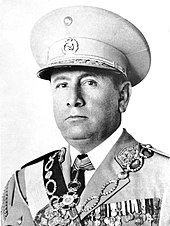
The history of Peru spans 15 millennia, extending back through several stages of cultural development along the country's desert coastline and in the Andes mountains. Peru's coast was home to the Norte Chico civilization, the oldest civilization in the Americas and one of the six cradles of civilization in the world. When the Spanish arrived in the sixteenth century, Peru was the homeland of the highland Inca Empire, the largest and most advanced state in pre-Columbian America. After the conquest of the Incas, the Spanish Empire established a Viceroyalty with jurisdiction over most of its South American domains. Peru declared independence from Spain in 1821, but achieved independence only after the Battle of Ayacucho three years later.

The politics of the Republic of Peru takes place in a framework of a unitary semi-presidential representative democratic republic, whereby the President of Peru is both head of state and head of government, and of a pluriform multi-party system. Executive power is exercised by the President and the Government. Legislative power is vested in both the Government and the Congress. The Judiciary is independent of the executive and the legislature. The Economist Intelligence Unit rated Peru a "hybrid regime" in 2022. Traditionally weak political parties saw their support collapse further in Peru since 2000, paving the way for the rise of personalist leaderships. The political parties in the congress of Peru are, according to political scientist Lucía Dammert, "agglomerations of individual and group interests more than solid and representative parties".

The economy of Peru is an emerging, mixed economy characterized by a high level of foreign trade and an upper middle income economy as classified by the World Bank. Peru has the forty-seventh largest economy in the world by total GDP and currently experiences a high human development index. The country was one of the world's fastest-growing economies in 2012, with a GDP growth rate of 6.3%. The economy was expected to increase 9.3% in 2021, in a rebound from the COVID-19 pandemic in Peru. Peru has signed a number of free trade agreements with its main trade partners. China became the nation's largest trading partner following the China–Peru Free Trade Agreement signed on 28 April 2009. Additional free trade agreements have been signed with the United States in 2006, Japan in 2011 and the European Union in 2012. Trade and industry are centralized in Lima while agricultural exports have led to regional development within the nation.
Red-baiting, also known as reductio ad Stalinum and red-tagging, is an intention to discredit the validity of a political opponent and the opponent's logical argument by accusing, denouncing, attacking, or persecuting the target individual or group as anarchist, communist, Marxist, socialist, Stalinist, or fellow travelers towards these ideologies. In the phrase, red refers to the color that traditionally symbolized left-wing politics worldwide since the 19th century, while baiting refers to persecution, torment, or harassment, as in baiting.

The Christian People's Party is a centre-right and conservative political party based on the principles of Christian democracy. It was founded in 1966 by Christian Democratic Party dissidents, led by Luis Bedoya Reyes, at the time mayor of Lima.

A self-coup, sometimes known as the Fujimorazo, was performed in Peru in 1992 after President Alberto Fujimori dissolved the Congress as well as the judiciary and assumed full legislative and judicial powers. With the collaboration of the military, the Fujimori government subsequently began to implement objectives of the Green Plan following the coup.

The Constitution of Peru is the supreme law of Peru. The current constitution, enacted on 31 December 1993, is Peru's fifth in the 20th century and replaced the 1979 Constitution. The Constitution was drafted by the Democratic Constituent Congress that was convened by President Alberto Fujimori during the Peruvian Constitutional Crisis of 1992 that followed his 1992 dissolution of Congress, was promulgated on 29 December 1993. A Democratic Constitutional Congress (CCD) was elected in 1992, and the final text was approved in a 1993 referendum. The Constitution was primarily created by Fujimori and supporters without the participation of any opposing entities.

Fujimorism denotes the policies and the political ideology of former President of Peru Alberto Fujimori as well as the personality cult built around him, his policies and his family, especially Keiko Fujimori. The ideology is defined by authoritarianism, its support for neoliberal economics, opposition to communism, and socially and culturally conservative stances such as opposition to LGBT rights and school curriculums including gender equality or sex education. Opponents of Fujimorism are known as anti-Fujimorists.

Vox is a national conservative political party in Spain. Founded in 2013, it is currently led by party president Santiago Abascal, vice presidents Jorge Buxadé, Javier Ortega Smith, Reyes Romero, and secretary-general Ignacio Garriga. Vox identifies itself as right-wing but has been described as far-right by academics and journalists.

José Pedro Castillo Terrones is a Peruvian politician, former elementary school teacher, and union leader who served as the President of Peru from 28 July 2021 to 7 December 2022. Castillo attempted to illegally dissolve Congress through a self-coup on 7 December 2022 while citing Congress' efforts to block his attempted policies, resulting in the legislative body impeaching and removing him from office the same day.
Censorship in Peru has been prevalent throughout its history. There have been multiple shifts in the level of freedom of the press in Peru, starting in the late 1900s when the country was oppressed, to the early 2000s when the country experienced more freedom; only recently has the country been ranked as partly free. After the neoliberal economic policies implemented in the 1990s stabilized the national economy and led it to an economic boom in the 21st century, usage of TV and access to internet has vastly increased, leading to more spaces of expression.

Since 2016, Peru has been plagued with political instability and a growing crisis, initially between the President, Pedro Pablo Kuczynski and Congress, led de facto by Keiko Fujimori. The crisis emerged in late 2016 and early 2017 as the polarization of Peruvian politics increased, as well as a growing schism between the executive and legislative branches of government. Fujimori and her Fujimorist supporters would use their control of Congress to obstruct the executive branch of successive governments, resulting with a period of political instability in Peru.

General elections were held in Peru on 11 April 2021. The presidential election, which determined the president and the vice presidents, required a run-off between the two top candidates, which was held on 6 June. The congressional elections determined the composition of the Congress of Peru, with all 130 seats contested.
The Lost Decade or the Crisis of the 80s was a period of economic stagnation in Peru throughout the 1980s which was exacerbated to a severe macroeconomic crisis by the end of the decade. Foreign debt accumulation throughout Latin America, a series of natural disasters, mass public expenditures, nationalizations of banks and financial institutions, and the shutting of Peru out of international credit markets led to a decade of macroeconomic decline. The financial crisis soon became adopted into the public sphere through hyperinflation in commodities, food shortages, and mass unemployment. By the end of the decade, Peru's gross domestic product (GDP) contracted over 20%, and poverty rose to 55%.

Rafael Bernardo López Aliaga Cazorla is a Peruvian businessman and politician, who is serving as mayor of Lima since 2023. He is currently the leader of Popular Renewal, the successor to National Solidarity reformed in 2020.

The terruqueo is a negative campaigning and often racist method of fearmongering used in Peru that involves describing anti-Fujimorists, left-wing political opponents and those who are against the neoliberal status quo as terrorists or terrorist sympathizers, with the tactic primarily being used by right-wing parties and Fujimorists to create a culture of fear. United Nations experts have condemned the use of the terruqueo, describing it as an intimidation tactic used by the government.

The Madrid Forum is an anti-communist organization created on 26 October 2020 by the Disenso Foundation think tank of the far-right Spanish political party Vox. Its founding document, the Madrid Charter, was primarily signed by conservative, ultraconservative, and far-right politicians from the Americas and the Iberian Peninsula.
The Lima Consensus are neoliberal, deregulatory, free market and ultraconservative policies Peru adopted since the presidency of Alberto Fujimori that are supported by the nation's economic elite. The description of such policies as the "Lima Consensus" was credited to Harvard University government professor Steven Levitsky. Such policies have made Peru attractive for foreign portfolio investment, though has resulted with increased economic inequality, crime, corruption and poor labor rights. Those who support the Consensus are often free-market fundamentalists and view any economic interventionism as socialism or communism.
Vanya Melissa Thais Iriarte is a conservative Peruvian political commentator. She gained prominence in Peruvian media for her strong opposition to Pedro Castillo during the 2021 Peruvian general election and her frequent controversial statements in the press.
Racism in Peru comprises negative attitudes and views on race or ethnicity which are related to each other, are held by various people and groups in Peru, and have been reflected in discriminatory laws, practices and actions at various times in the history of Peru against racial or ethnic groups. Peruvian intellectuals, who were mainly white and based in the developed capital city of Lima, historically denied that racism existed in Peru and did not focus on the social issue, often participating in racism themselves. The concentration of wealth amongst elites in Lima through centralismo resulted with a history of systemic racism in Peru, with individuals in Lima basing their discrimination against rural individuals due to race and geographical location.
















